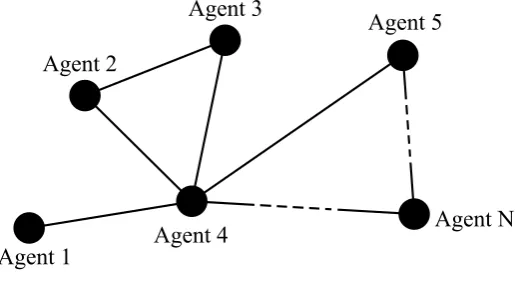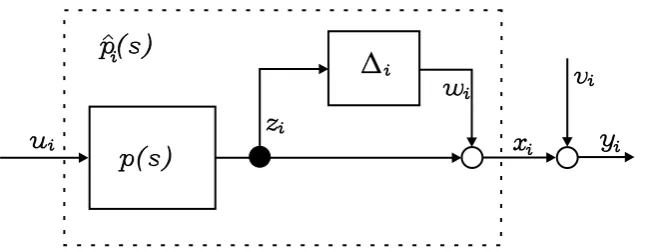DETERMINATION OF THE ROBUST
CONDITION ON CONSENSUS SYSTEM
UNDER THE COMMUNICATION
CONSTRAINTS
M. Romi Syahputra, Herman Mawengkang, Tulus
Abstract.This paper discuss about the robust consensus problem of a multi-agent systems under the communication constraints described by a communication graph. The uncertainty of each agent is modeled as a norm-bounded multiplicative uncertainty. A necessary and sufficient condition for achieving the robust consensus is characterized in terms of the eigenvalues of the weighted Laplacian of the communication graph. In the case where the nominal transfer function shared by all the agents is positive real, the robust consensus condition turns out to depend only on the largest eigenvalue.Sincep(s) is positive real and λN > 0, the lower bound of the stability margin is given byδ≥1. The stability margin δ¯
increases for a smallerλN. Hence, when p(s) is fixed, the optimal stability margin can be obtained by minimizingλN.
Keywords: Robust consensus, Multi-agent system, Laplacian matriks, Communi-cation graph
1. INTRODUCTION
Multi-agent system came from the ’Distributed Artificial Intelligence’. The rapid advances in information technology bring good impact on the develop-ment of multi-agents that have can be easily impledevelop-mented in practice. There
Received 12-11-2012, Accepted 15-12-2012. 2010 Mathematics Subject Classification: 90B18
Key words and Phrases: robust consensus, multi agent system, laplacian, communication.
are so many examples of applications that implement multi-agent systems, such as ACORN (Agen-base Community Oriented Routing Network) and FIPA-OS created by the Foundation for Intelligent Physical Agents. Not only in the field of computers or networking, multi-agent systems are also widely used in other disciplines, such as physics, biology, robotics, genetics, etc.
Multi-agent system can be defined as a collection of intelligent agents (software or program) which interact and work together to achieve a goal. Durfeeet al. [3] defined a multi-agent system as a network of problem solvers that work together to solve problems that can not be solved by the capacity of the individual. A multi-agent system is defined as a system consisting of a population of autonomous agents that interact with each other to achieve the same goal, and at the same time pursuing the objective of each agent individually.
One of the research is to analyze robustness in multi-agent system. As in the study Takaba [5] derived a sufficient condition for robust output synchronization against gain-bounded uncertainties for the case where the nominal agents are incrementally passive nonlinear systems. In the case of LTI multi-agent system, Hara and Tanaka [4] derived a condition for robust stability by using a generalized frequency variable representation.
GraphG= (V, E) is used to represent a consensus problem in multi-agent system. In this case, the set of V = {v1, v2,· · · , vN} represents the
agents, whereas the set of E ={e1, e2,· · · , eN} represents the relationship
or communication that occur between agenti thand j thagent. Generally, matrices are often used to represent a graph. In this paper, the author use a Laplacian matrix(L) to represent communication between each agent. Chung [2] in his book ”Spectral Graph Theory” has been explained several theories about the Laplacian matrix.
2. PROBLEM FORMULATION
In the previous chapter, it has explained that the issue of consensus that will be presented related to the multi-agent system. A multi-agent system consisting ofN agents can be represented as in figure 1.
Figure 1: Multi agent system
Each agent is described by the input-output equations:
xi = ˆpi(s)ui, yi=xi+vi, i= 1,2, . . . , N (1)
where xi,yi,ui and vi are the controlled output, the measured output, the
control input, and the measurement noise, respectively. Meanwhile, ˆpi(s)
is a SISO (Single-Input-Single-Output) transfer function which indicates the dynamics of each agent in the system.
ˆ
pi(s) = (1 + ∆i(s))p(s) (2)
wherep(s) denotes the nominal dynamics shared by all agents.
The transfer function contains multiplicative uncertainty ∆i(s) which
represents modeling errors and/or heterogeneity in the individual agents. It can be seen in figure 2.
By using (2), the system equations in (1) is reduced to:
zi = p(s)ui xi = zi+wi
yi = xi+vi (3)
Assume that ∆i(s) is a stable transfer function whose H∞-norm is
bounded by a constantδ that belongs to the set Bδ defined by:
Bδ:={∆∈H | k∆k∞≤δ}
In this case,δ can be interpreted as the distance between the agent i
with agent j.
Figure 2: Agent with multiplicative uncertainty
Defined some vector matrix as follows:
x=
Thus, (3) is equivalently rewritten as:
z = p(s)u x = z+w
y = x+v (4)
2.1 Communication Graph
Communication among the agents is performed through the network defined by the undirected graph G = (V, E), where V ={1,2, . . . , N} is the set of nodes, and E ⊆ {(i, j)|i, j ∈V} is the set of edges. The node i∈ V repre-sents thei thagent. The edge (i, j)∈E represents two-way communication link between agenti and j. At each time, agent itransmits information yi
to its neighbors j, (i, j)∈E.
The assumption was that the communication graphG= (V, E) is linear time-invariant, it means that the communication between agentiand agent
j does not change over time.
Suppose chosen an orthonormal basis and Q ∈ R(n−1)×n is a matrix formed by that basis. Qsatisfies,
Q1N = 0 (5)
where matrix U satisfies
Thus,
hu,˜ v˜i= 1 2N
N
X
i=1
N
X
j=1
hui−uj, vi−vji
2.2 Linear Consensus Protocol
The consensus problem is to design a protocol (distributed control law) which drives the outputs of all agents towards the same value, i.e., yi − yj, i, j ∈ V should converge to zero, or should be sufficiently small in the presence of measurement noises. Linear consensus protocol is defined as equation (11).
ui =− X
j∈Ni
aij(yi−yj) (11)
or equivalently,
˙
x=u=−Ly =−L(x+v) (12)
Thus, multi-agent system equation can be expressed by:
z = −p(s)L(x+v)
x = −p(s)L(x+v) +w (13)
w = ∆(s)z
From lemma 2.1, it can be seen thatH2-norm can be obtained by this
equation.
kxk2 =
1 2N
X
i,j∈V
kxi−xjk22
1/2
(14)
3. ROBUSTNESS ANALYSIS
Equation (13) can be transformed into a product of two matrices as follows:
"
Then do linear fractional transformation to obtain a transfer function ˆG(s) and ˆH(s) as follows:
ˆ
G(s) = −(IN +p(s)L)−1p(s)L (15)
ˆ
H(s) = (IN +p(s)L)−1 (16)
By applying these transformations, it is obtained:
"
then multi-agent system equation in (13) becomes (17) and (18) as below:
z = −(IN +p(s)L)−1p(s)Lw−(IN+p(s)L)−1p(s)Lv (17)
Therefore, the consensus analysis for multi-agent system of (13) is equivalently reduced to the robust stability analysis of the LFT system in eq (17) and (18). It is obvious that the consensus is achieved for the nominal case (∆(s) = 0) if and only ifG(s) is stable.
Note thatG(s) is a diagonal transfer matrix. This can be seen by the definition ˆLin equation (10).
G(s) = diag(g2(s),g3(s), . . . ,gN(s)) (21)
gi(s) = p(s)λi
Proposition 3.1 The multi-agent system in eq. (13)achieves the nominal consensus if and only if
d(s) +n(s)λi, i= 2,3, . . . , N (23)
is a Hurwitz polynomial, where (d, n) is a pair of coprime polynomials satisfying p(s) =n(s)/d(s).
Proposition 3.2 The multi-agent system of (13) achieves the robust con-sensus if and only if it achieves the nominal concon-sensus, and
p(s)λi
1 +p(s)λi
∞
< δ−1, i= 2,3, . . . , N (24)
From this condition, we can compute the stability margin (δ) of the multi-agent system as:
δ = 1
max
i∈[2,...,N]
p(s)λi 1+p(s)λi
∞
= max
i∈[2,...,N] p(sinf)∈R+
1 + 1
p(s)λi
(25)
3.3 Consensus for nominally passive agents
As has been assumed in the previous section, each agent in the system is nominally passive. This means that the transfer function p(s) is positive real.
From proposition 3.1, it is known that d(s) + n(s)λ is a Hurwirtz polynomial for each λ > 0. Thus, the requirement to obtain a nominal consensus can be seen in proposition 3.3.
Proposition 3.3 Assume that p(s) is positive real. Thus, multi-agent sys-tem in equation (13) nominal gain consensus if and only if it satisfies:
(i.) d(s) is Hurwirtz Polynomial. That is a polynomial that each coeffi-cient is positive and the roots is 0 or negative.
In addition to the propositions (3.3), the following lemma plays an important role for the robust consensus.
Lemma 3.2 Assume that p(s) is positive real. Then,
Proof: The inequality in the lemma is equivalent to
(1 +p(s)λ′)2λ2−(1 +p(s)λ)2λ′2 ≥0 (26)
By direct calculation, it is obtained:
(λ2−λ′2) + 2λλ′(λ−λ′)p(s)
Since p(s)≥0 and λ > λ′, it is concluded that (26) is satisfied.
Therefore, it is obtained the following proposition regarding the robust consensus for the positive real case.
Proposition 3.4 Assume that p(s) is positive real. Then, the multi-agent system (13) achieves the robust consensus if and only if it achieves the nom-inal consensus, and
Thus, the stability margin in (25) becomes:
δ = inf
The relationship between the topology graph used is closely related to the value of the stability margin on robust consensus. This is because the eigenvalues of each used topologies are different.
5. CONCLUSION
(i) The nominal consensus is achieved as long as the graphGis connected (λ2>0).
(ii) A necessary and sufficient condition for achieving the robust consensus against norm-bounded uncertainties is characterized in terms of the eigenvalues of the associated Laplacian matrix of the communication graph. In the case where the nominal transfer functionp(s) is positive real, the consensus condition turned out to depend only on the largest eigenvalue.
(iii) Sincep(s) is positive real andλN >0, the lower bound of the stability
margin is given byδ ≥1.
(iv) It is seen in lemma (3.2) that the stability margin ¯δ increases for a smaller λN. Hence, when p(s) is fixed, the optimal stability margin
can be obtained by minimizingλN. The minimization of the eigenvalue
of the weighted Laplacian was considered by Boyd [1] .
References
[1] Boyd, S. (2006). Convex Optimization of Graph Laplacian Eigenvalue. Proc. of Int. Congress of Mathematicians, pp. 1311-1319 171-183.
[2] Chung, F. R. K. (1997). Spectral Graph Theory, CMBS Lecture Notes 92. American Mathematical Society, Providence, RI.
[3] Durfee, A., Carley, K., and Lesser, V. (1989).Reflections on the nature of multi-agent coordination and its implications for an agent architec-ture. Autonomous Agents and Multi-Agent Systems, 1:89111. 299330. MIT-press.
[4] Hara, S., and Tanaka, H. (2010).D-Stability and Robust Stability Con-ditions for LTI System with Generalized Frequency Variable. Proc. of 49th IEEE Conf. Decision and Control.
[5] Takaba, K. (2011).Robust Synchronization of Multiple Agents with Un-certain Dynamics. Proceeding of 18th IFAC Triennial World Congress, Milano, Italy. pp. 8780-8784.
M. Romi S: Graduate School of Mathematics, Faculty of Mathematics and Natural Sciences, University of Sumatera Utara, Medan 20155, Indonesia.
Herman Mawengkang: Department of Mathematics, Faculty of Mathematics and Natural Sciences, University of Sumatera Utara, Medan 20155, Indonesia.
E-mail: mawengkang@usu.ac.id
Tulus: Department of Mathematics, Faculty of Mathematics and Natural Sciences, University of Sumatera Utara, Medan 20155, Indonesia.

